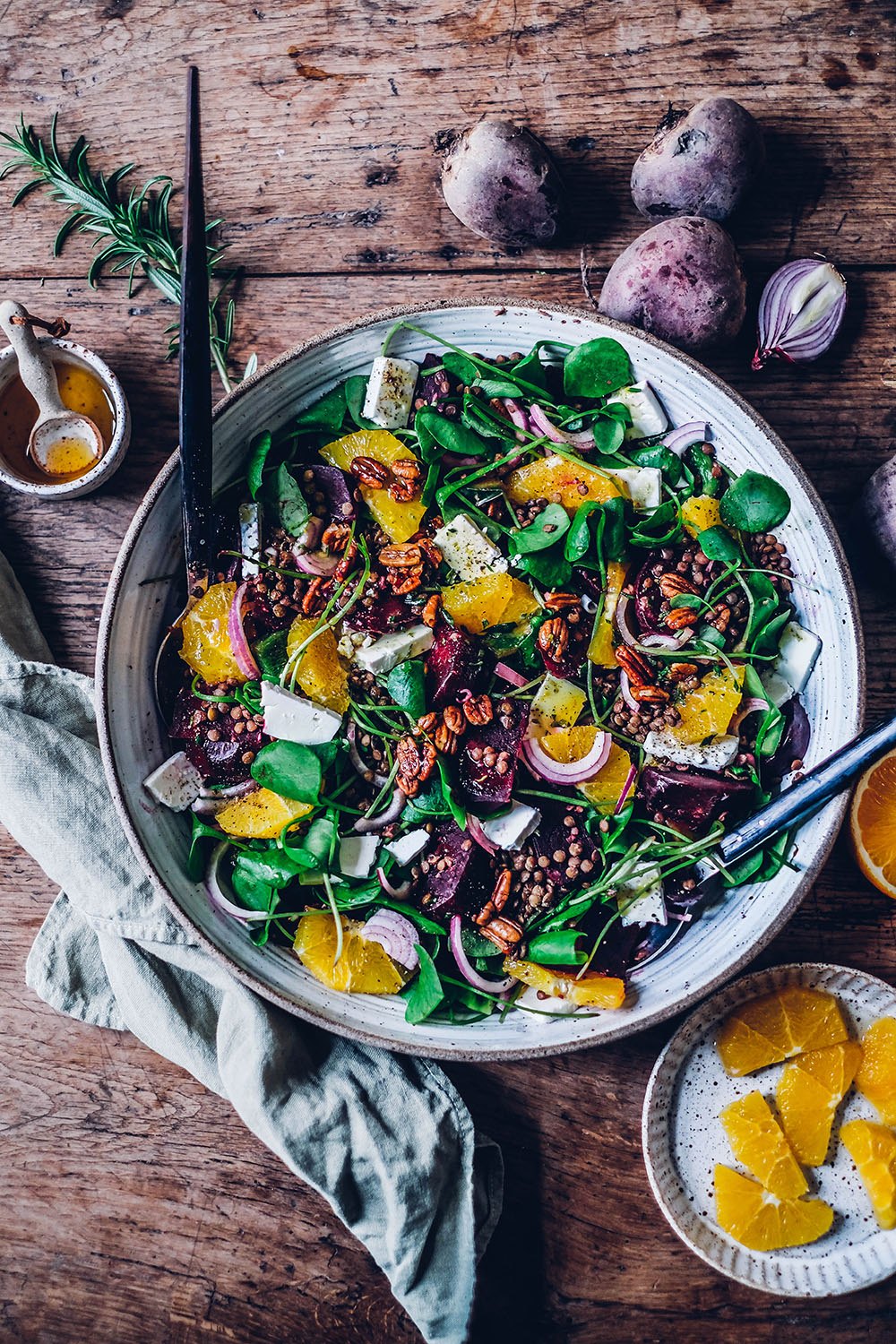
Wintry warm Beetroot Lentil Salad with Feta Cheese and Rosemary
Today we want to share a delicious new wintry salad recipe with you guys!
*In collaboration with Fissler
The cold season has really arrived and we long for cozy hours and shared meals. Of course, nothing works for us in winter without beetroot 🙂
And anyone who loves to eat beetroots knows that it takes a little patience when it comes to cooking time.
That’s why we were very happy when Fissler provided us with a pressure cooker with which everything can be prepared much faster. We only knew a pressure cooker from our grandparents, who proudly showed us their new purchase, who is saving so much time.
The Fissler Vitavit® Premium is our first pressure cooker, probably because we never really dared to try it, because we thought it was something for itself and reading manuals isn’t really our thing either. But right from our first attempts at cooking, everything worked out so easily and wonderfully that we can’t wait to try out more recipes – and as a risotto lover, the pressure cooker is of course a must-have! Today we have a delicious winter salad for you that is bursting with fresh ingredients and vitamins – so winter can come.
Our Vitavit®Premium is a great kitchen helper, it not only saves time in preparation, but also energy, since the cooking time is significantly reduced and the cooking flame no longer has to be set very high after heating up during the cooking process. After heating up, 2/3 of the stove power is sufficient for full power or the flame can be turned down even further depending on the pressure.
What we also found great is that you need surprisingly little water, e.g. for quick cooking with the insert, we only filled the pot with 250ml of water to cook the beetroots (the measuring scale in the pot indicates the minimum amount of liquid), which also means a plus in terms of natural resources. An with the removal of atmospheric oxygen and the shorter cooking times, foods are cooked very gently. Vitamins, minerals and flavors are better preserved. Simply place the tripod in the pot, fill the pot with some water, fill the perforated insert with your favorite vegetables and place it on the tripod, close the lid and off you go.
We will definitely be preparing this delicious winter salad again in the next few days, as it is really quick to make and even cooking lentils and beetroot is done in no time thanks to the pressure cooker!
And here is a brief overview of how simple the Vitavit® Premium pressure cooker is be used:
Putting the lid on is very easy as there is locking indicator so you can be sure the pot is locked. After closing, you set the cooking settings on top of the lid on the multi-function valve, the pressure cooker has 4 cooking settings (including a pressureless steam cooking setting) – we used e.g. cooking setting 2 for the beetroots and lentils. When the pot then heats up, the integrated “traffic light system” of the multi-function valve slowly rises due to the pressure in the pot and it shows yellow (just before the optimal cooking temperature), green (optimal temperature) or red (reduce the heat until you see the green ring again). And after cooking, you can easily let the steam escape by slowly turning towards the steam symbol on the multi-function valve. Incidentally, the base is suitable for all types of cookers and is made in Germany. And in the pot, a measuring indicator on the inside makes it easier to calculate the quantity or liquid dosing.
Basically, fine, delicate vegetables and fish are cooked at level 1, robust vegetables at level 2 and meat, potatoes, soups, etc. at level 3. The cooking times are reduced at level 3 to around half to a third of the normal cooking time. At level 2, the cooking time is around 25% longer than at level 3 and at level 1 around 50% longer than at level 3. However, the exact cooking time always depends on the size and quality of the food.
As the next blog recipe for the Fissler Vitavit® Premium, we have planned a delicious rice pudding dessert with cranberry compote and Christmas spices for the coming weeks. So stay tuned and have fun cooking!
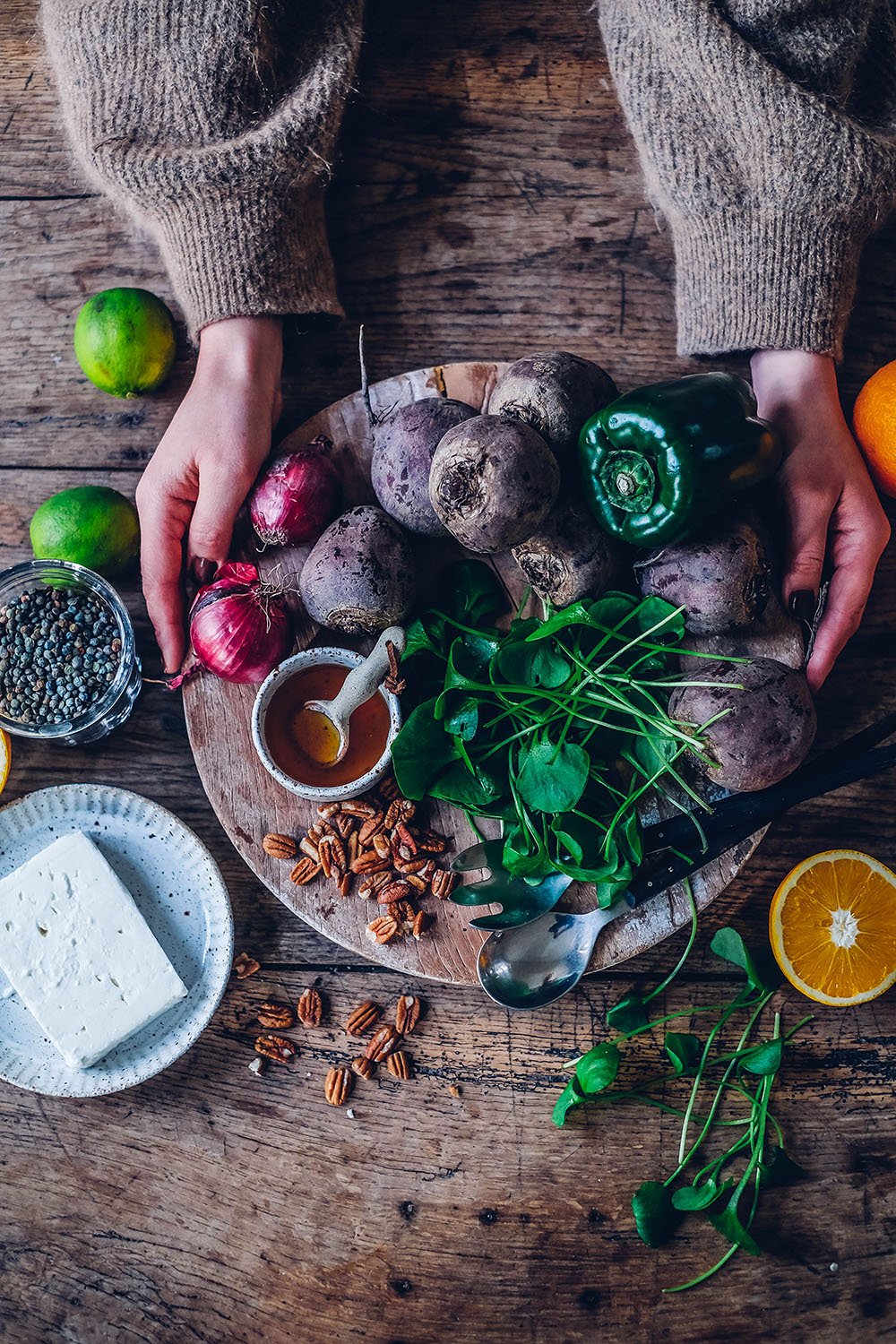
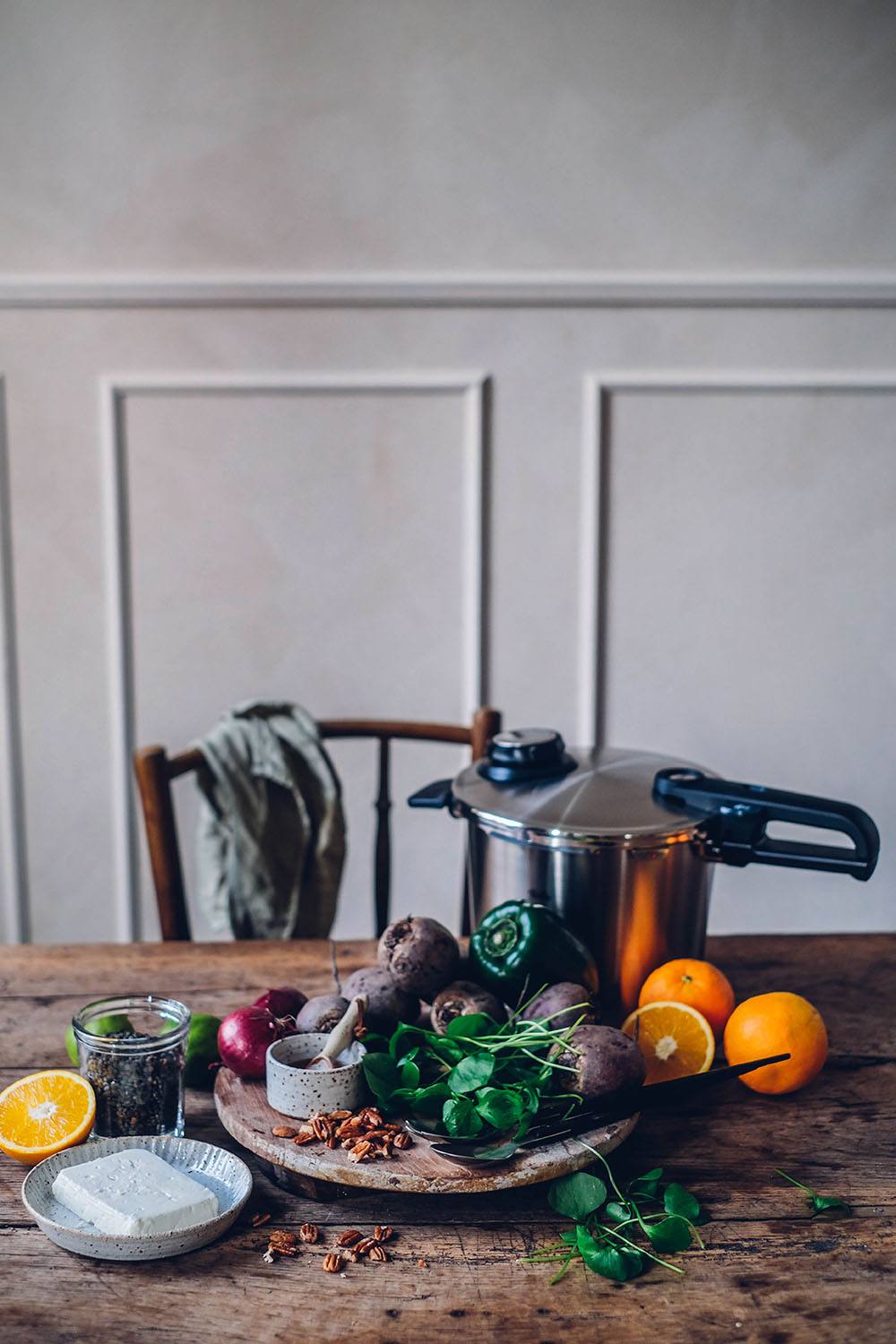

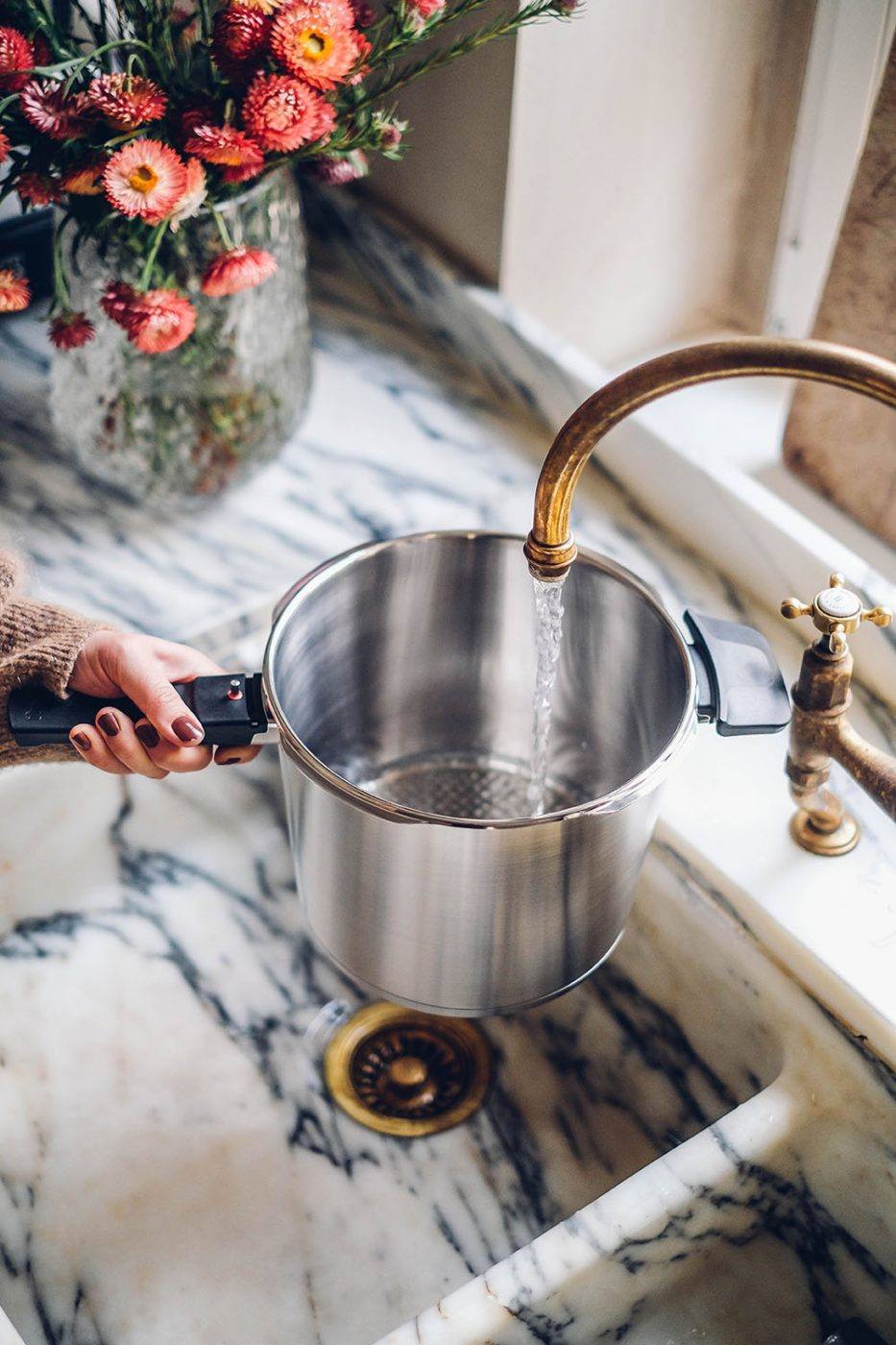
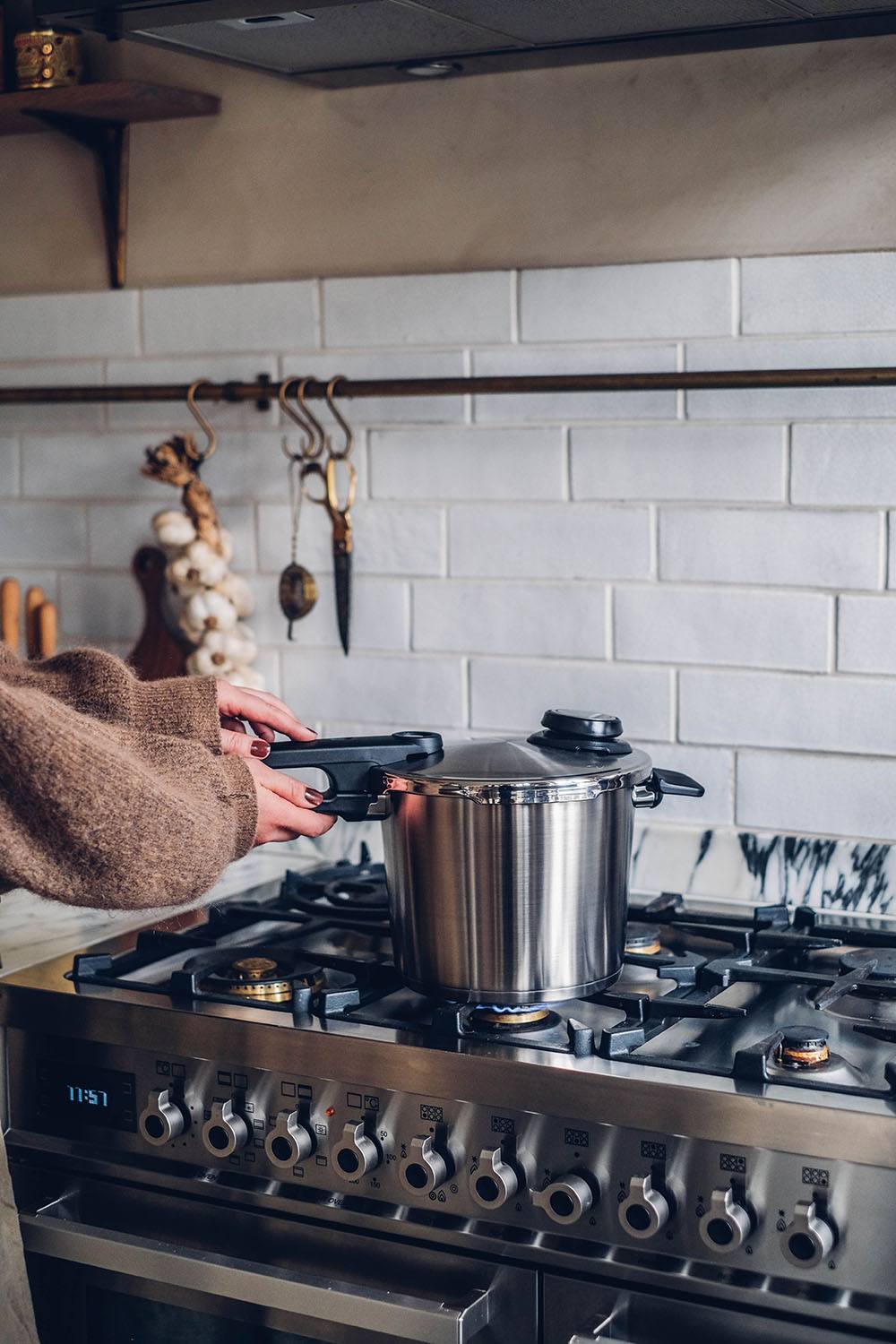
Wintry warm Beetroot Lentil Salad with Feta Cheese and Rosemary
Ingredients for 4 persons
Ingredients for the salad
- 500-600g beetroot (if possible the same size and preferably a smaller size for a shorter cooking time)
- 60g winter purslane or baby spinach
- 1 red onion
- 1 green bell pepper
- 2 oranges
- 250g green lentils
- 1/2 tsp salt
- 50g pecans or walnuts
- 1 tsp coconut oil
- 1/2 tbsp honey
- 180g feta cheese
- salt & pepper
Ingredients for the dressing
- 1-2 sprigs of rosemary
- 4 tbsp olive oil
- 1 tbsp white wine vinegar
- 2 teaspoons mustard
- 2 tsp runny honey
- juice of 1 lime
- salt & pepper
Pour 250ml water into the pressure cooker, then insert the tripod. Place the beetroots (unpeeled) in the perforated insert and place on the tripod. Close the pressure cooker, turn the pressure regulator to setting 2 and heat the pot. First, the pressure cooker heats up and the steam escapes until the valve closes (then enough pressure has built up), then the pressure regulator slowly rises, first you see a yellow ring, then a green ring – now the optimum heat has been reached and you can reduce the heat a bit – now set the timer to 20 minutes for the beetroot. If the cooking crown continues to rise to red, then reduce the heat even more until it levels back to green.
While cooking, prepare the dressing: remove the rosemary leaves from the stem and chop finely. Then mix the chopped rosemary with the remaining ingredients and season with salt and pepper. Then clean and dry the winter purslane ideally using a salad spinner. Cut the onion into fine rings and cut the green bell pepper into bite-sized pieces. Cut off the skin of the orange generously, halve the flesh and cut into slices. Put the winter purslane, onion, green bell pepper and orange fillets in a salad bowl.
After 20 minutes of cooking, turn off the stove. To release the steam, turn the pressure regulator very slowly to the steam position until all the steam has escaped – this can take 2-3 minutes. Then open the lid and lift out the insert with a tea towel. Set the beets aside to cool. Clean the pot. Now rinse the lentils and put them in the pressure cooker together with 600ml water and 1/2 tsp salt. Set cooking setting 2 and heat the pot until the green ring becomes visible – now cook the lentils for 10 minutes. Meanwhile, caramelize the pecans together with the coconut oil and honey in a non-stick pan for about 2 minutes. Peel the beetroots like jacket potatoes and cut into wedges. Add the beetroot wedges and pecans to the salad ingredients. After 10 minutes turn the pressure regulator to the steam setting again to let off steam. Then sieve lentils and put them in the salad bowl. Mix everything well. Finally, cut the feta into fine strips and fold in together with the dressing. Season with salt and pepper.
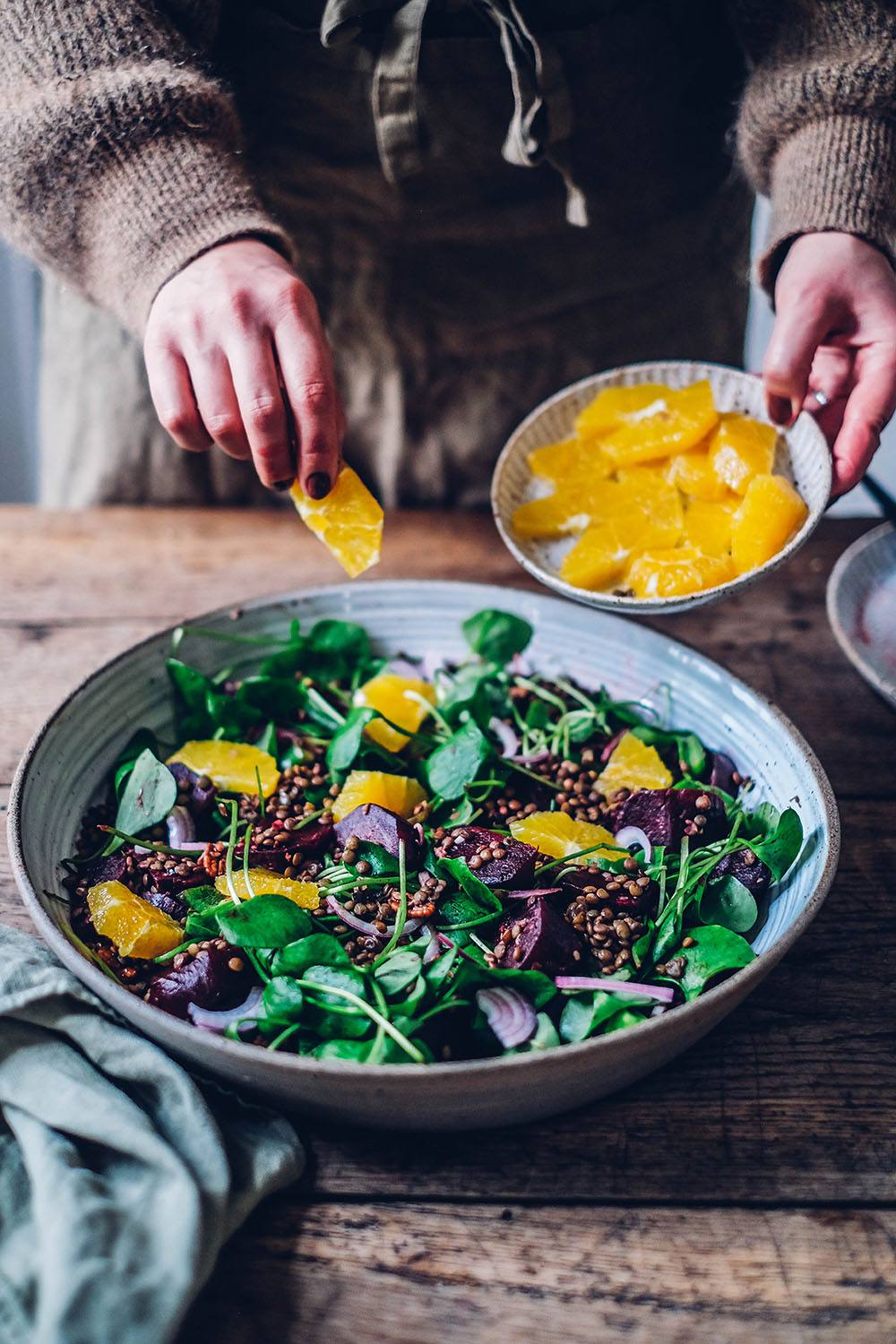
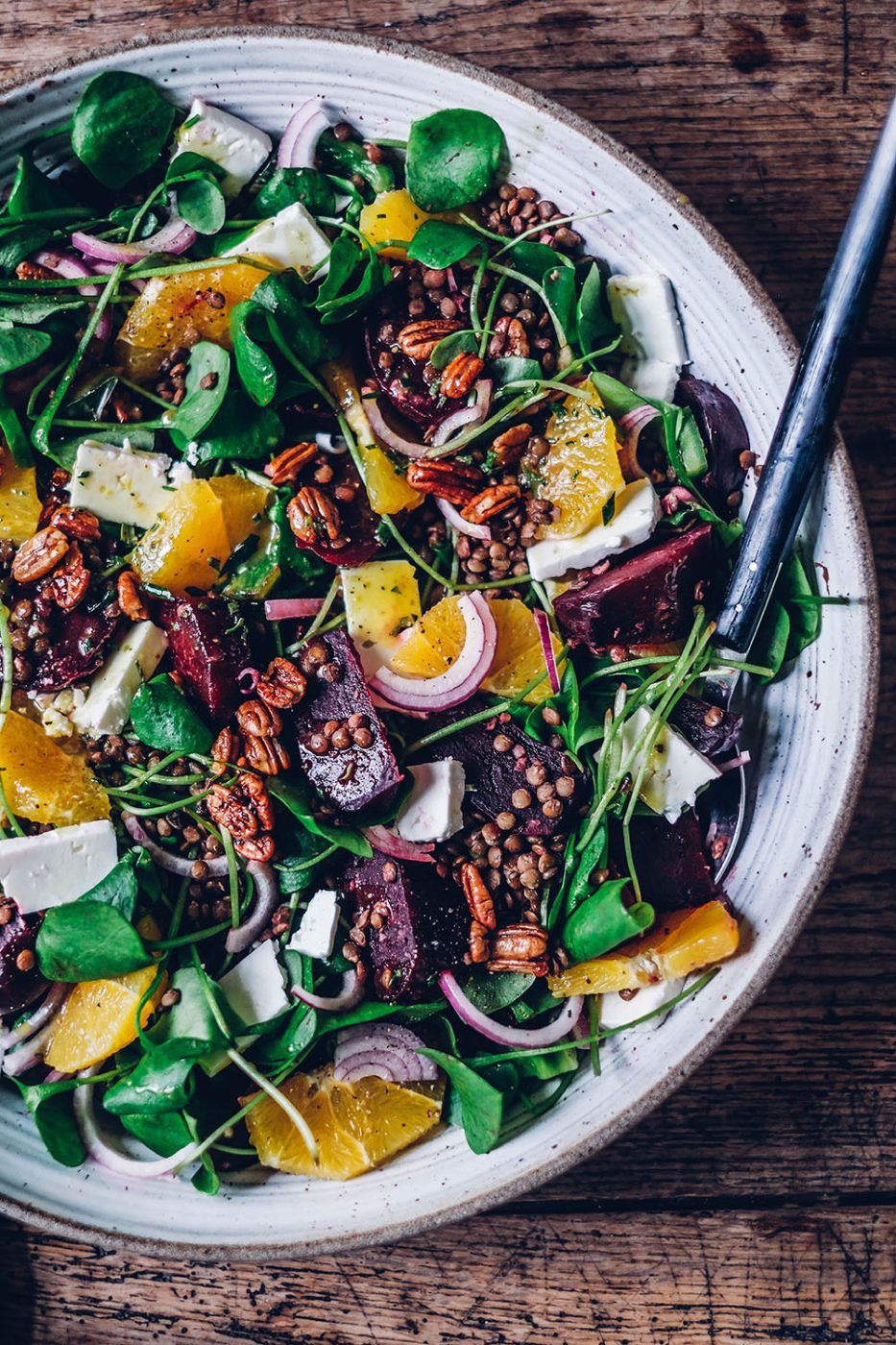


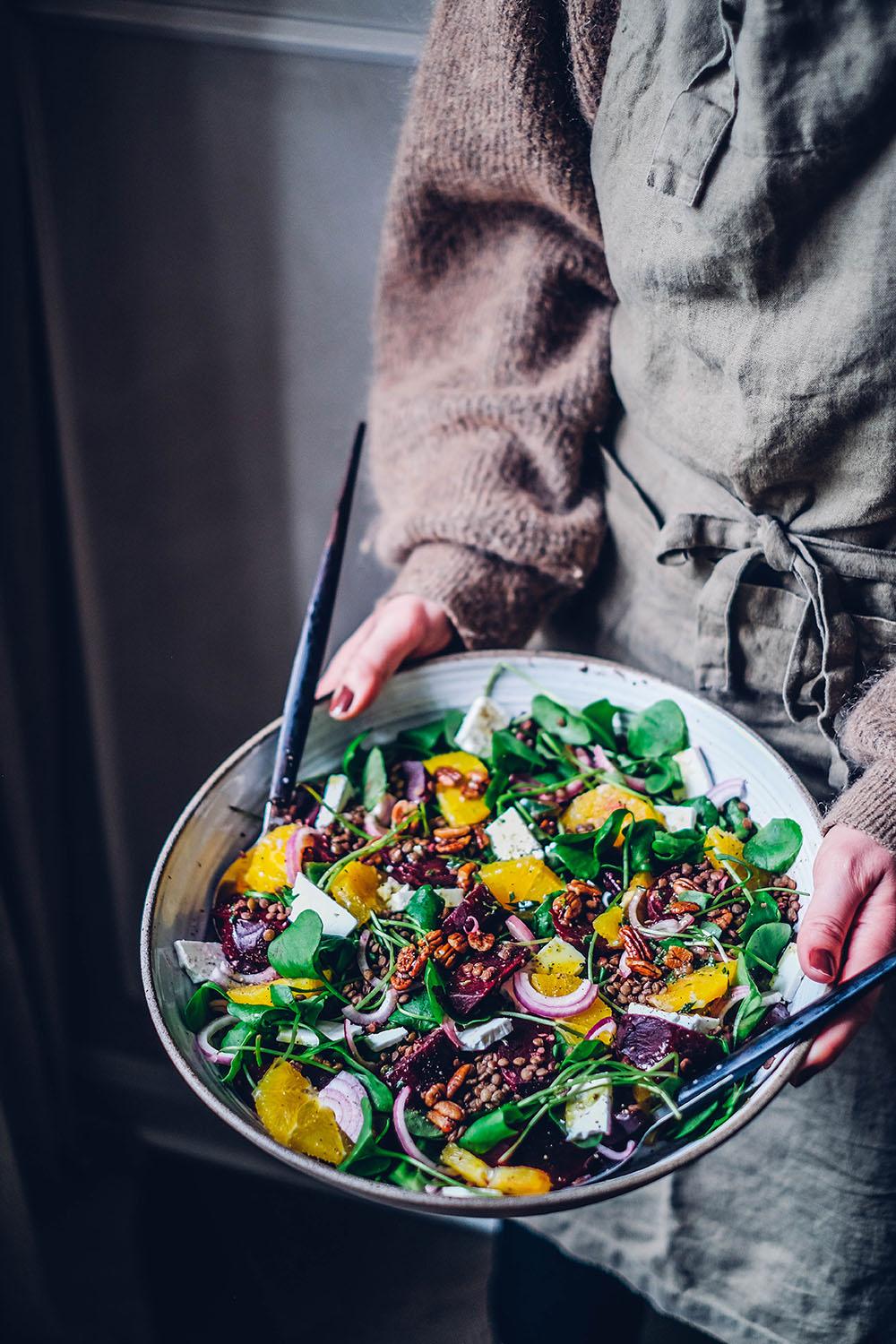
German Translation
Ihr Lieben! Die kalte Jahreszeit ist jetzt richtig angekommen und wir sehnen uns nach gemütlichen Stunden und gemeinsamen Essen. Natürlich geht im Winter nichts ohne rote Beete bei uns 🙂 Und jeder, der gerne rote Beete isst, weiß, dass man bei der Kochzeit etwas Geduld braucht. Deswegen haben wir uns sehr gefreut, als Fissler uns einen Schnellkochtopf zur Verfügung gestellt hat, mit dem alles viel schneller zubereitet werden kann. Einen Schnellkochtopf kannten wir bisher nur von unseren Großeltern, die stolz über die Zeitersparnis Ihrer Neuanschaffung geschwärmt haben. Der Fissler Vitavit® Premium ist unser erster Schnellkochtopf, wahrscheinlich weil wir uns nie so recht daran gewagt haben, weil wir dachten, es wäre so eine Sache für sich und Bedienungsanleitungen durchzulesen ist auch nicht so unser Ding. Aber gleich bei unseren ersten Kochversuchen hat alles so easy und wunderbar geklappt, dass wir gar nicht erwarten können mehr Rezepte auszuprobieren – und gerade als Risotto-Liebhaber ist der Schnellkochtopf natürlich ein Must Have! Heute haben wir ein leckeren winterlichen Salat für Euch, der nur so strotzt vor frischen Zutaten und Vitaminen – da kann der Winter ruhig kommen.Unser Vitavit® Premium ist dabei ein toller Küchenhelfer, er spart nicht nur Zeit in der Zubereitung, sondern auch Energie, da die Kochzeit sich deutlich verkürzt und die Kochflamme nach dem Aufheizen beim Garprozess nicht mehr sehr hoch eingestellt werden muss. Nach dem Aufheizen reicht 2/3 Herdleistung für volle Leistung aus bzw. kann die Flamme je nach Druck noch weiter heruntergedreht werden.Was wir auch toll fanden, ist, dass man z.B. für das Schnellkochen mit dem Einsatz überraschend wenig Wasser benötigt, wir haben für das Kochen der roten Beete gerade mal 250ml Wasser in den Topf gefüllt (die Mess-Skala im Topf gibt die Mindestmenge an Flüssigkeit vor), was auch ein Plus im Hinblick auf die natürlichen Ressourcen bedeutet. Schnellkochen unter Druck ist auch super gesund und eine der schonendsten Zubereitungsarten, da viele Nährstoffe erhalten bleiben und nicht durch Sauerstoff oder Wasser zersetzt werden. Einfach das Dreibein in den Topf stellen, etwas Wasser in den Topf füllen, den gelochten Einsatz mit Lieblingsgemüse befüllen und auf das Dreibein stellen, Deckel verschliessen und los geht’s. Wir werden auf jeden Fall in den nächsten Tagen diesen köstlichen Wintersalat wieder zubereiten, da er wirklich schnell gemacht ist und selbst das Linsen und Rote Beete kochen dank dem Schnellkochtopf im Nu erledigt ist! Und hier noch ein kleiner Überblick über die einfache Bedienung des Schnellkochtops Vitavit Premium:Das Aufsetzen des Deckels ist sehr einfach, da es eine Verriegelung mit einer Anzeige gibt, so kann man sicher gehen, dass der Topf auch verschlossen ist. Nach dem Verschliessen stellt man die Garstufe oben auf dem Deckel an der Kochkrone ein, der Schnellkochtopf hat 4 Garstufen (inklusive einer drucklosen Dampfgarstufe) – wir haben z.B. die Garstufe 2 für die rote Beete bzw. die Linsen verwendet. Wenn der Topf sich dann erhitzt, hebt sich die Kochkrone langsam durch den Druck im Topf und dank der Kochanzeige mit Ampelfunktion zeigt diese Gelb (kurz vor der optimalen Garstufe), Grün (optimale Hitzezufuhr) oder Rot (Hitzezufuhr reduzieren, bis man den grünen Ring sieht). Und nach dem Kochen kann man mithilfe des langsamen Drehens Richtung Dampfsymbol auf der Kochkrone den Dampf ganz einfach entweichen lassen. Der Boden ist übrigens für alle Herdarten geeignet und in Deutschland hergestellt. Und im Topf erleichtert eine Messanzeige an der Innenseite die Mengen-bzw. Flüssigkeitsdosierung. Grundsätzlich gart man feines, empfindliches Gemüse und Fisch auf Stufe 1, robustes Gemüse auf Stufe 2 und Fleisch, Kartoffeln, Suppen o.ä. auf Stufe 3. Die Garzeiten verkürzen sich bei Stufe 3 auf etwa die Hälfte bis ein Drittel der normalen Garzeit. Bei Stufe 2 dauert die Garzeit etwa 25% länger als auf Stufe 3 und auf Stufe 1 etwa 50% länger als auf Stufe 3. Die genaue Garzeit richtet sich aber immer auch nach Größe und Qualität der Lebensmittel.Als nächstes Blog-Rezept für den Fissler Vitavit® Premium haben wir ein leckeres Milchreis-Dessert mit Cranberry-Kompott und weihnachtlichen Gewürzen für die kommenden Wochen geplant. Bleibt also dran und viel Spaß am nachkochen!
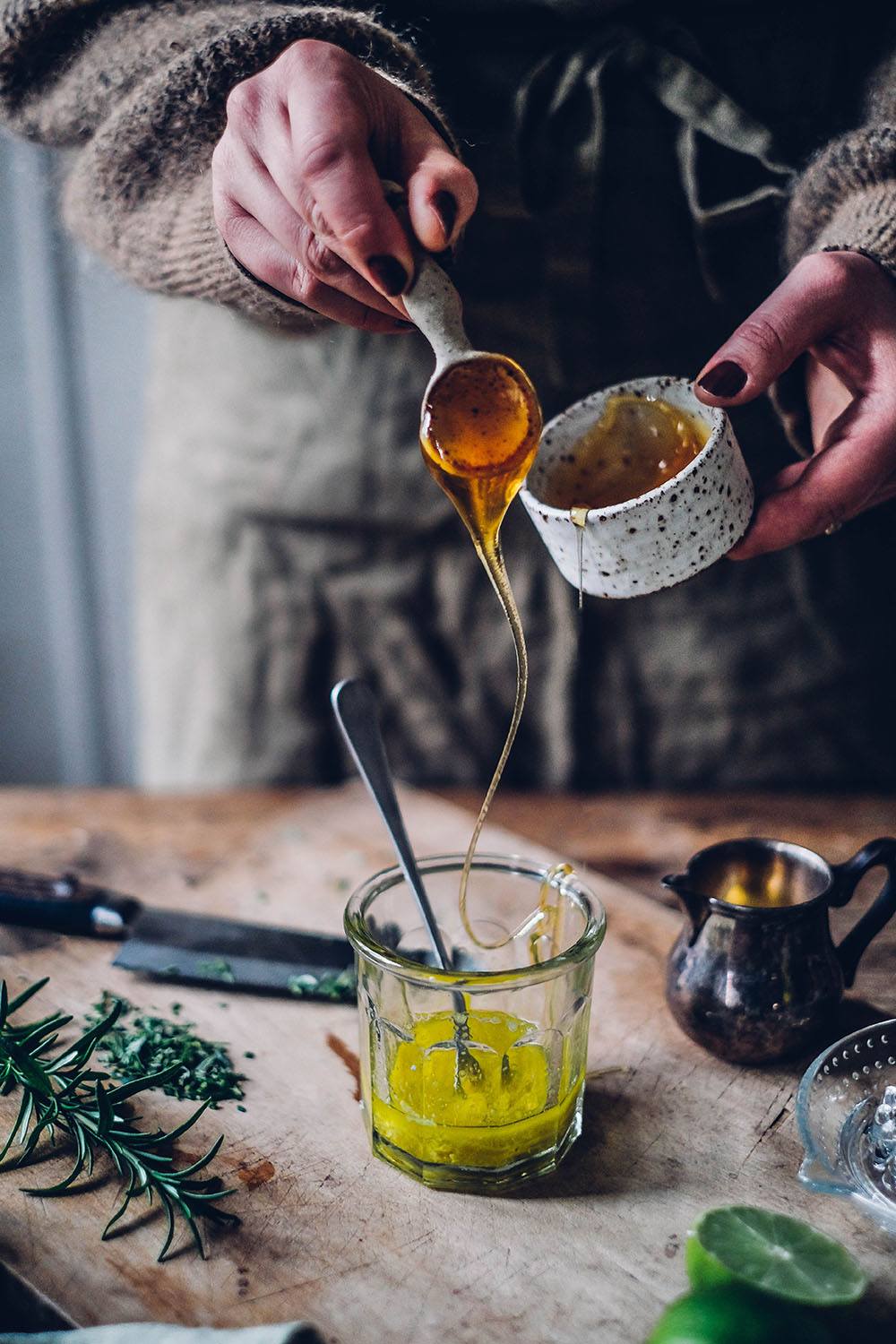

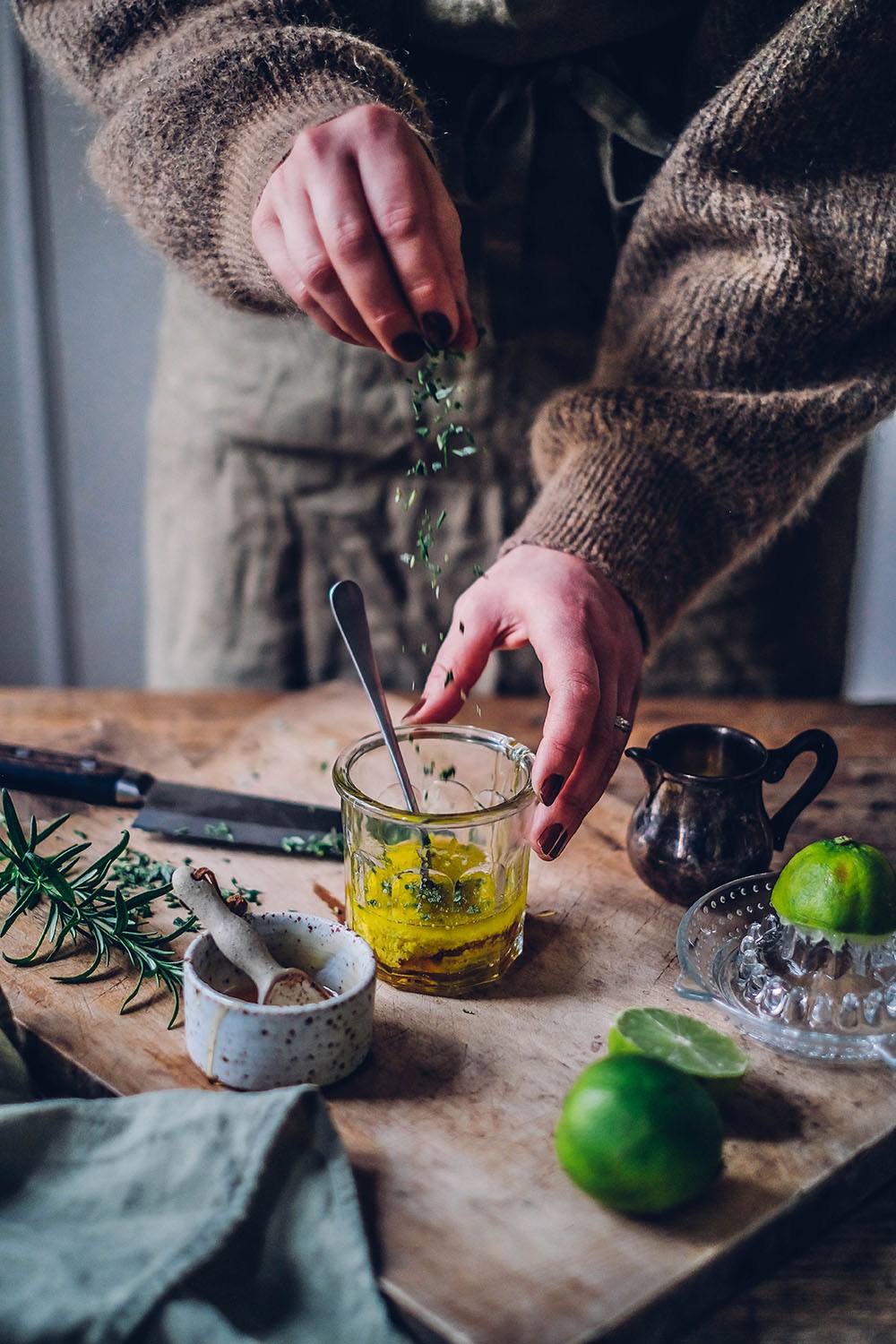
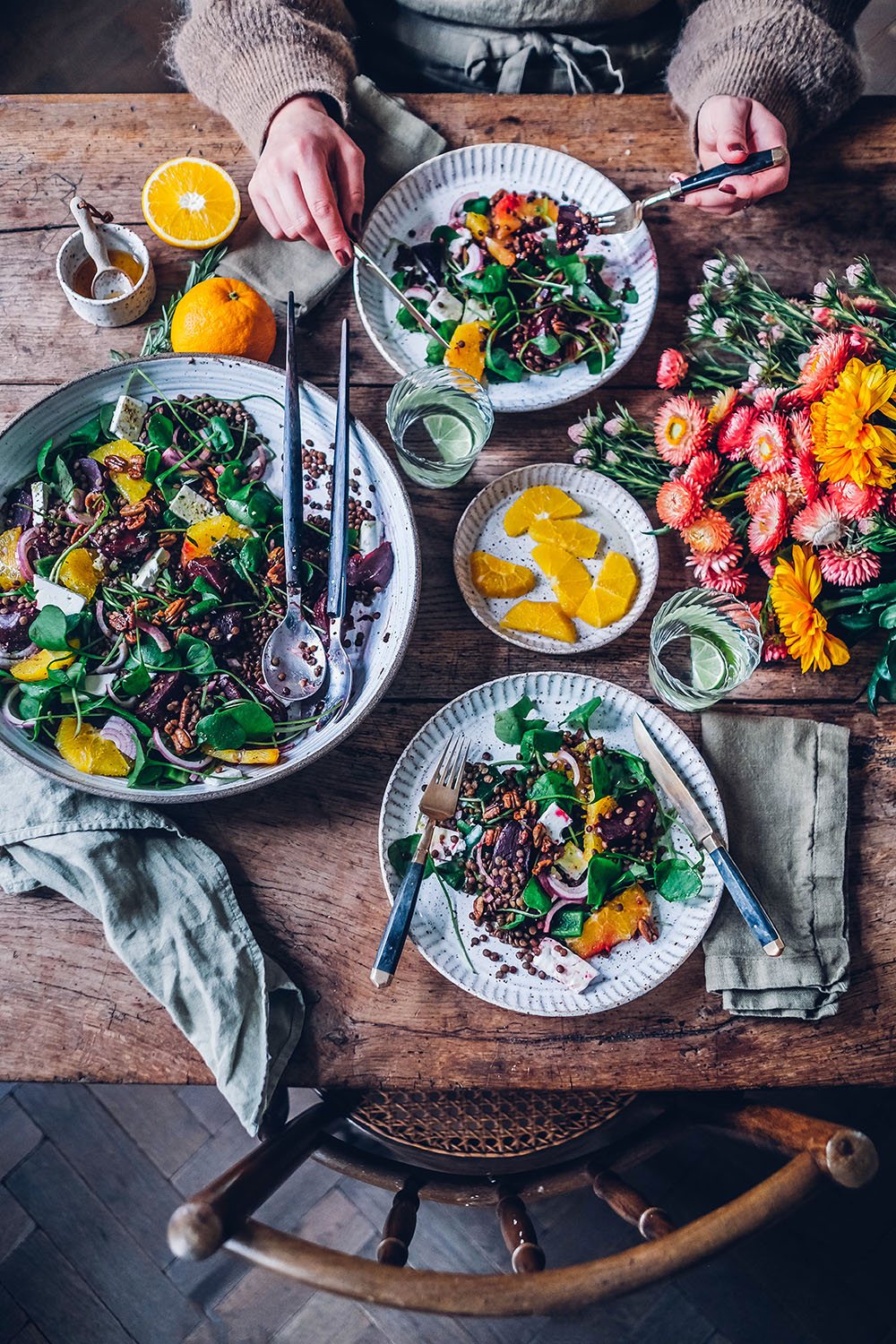
Winterlicher warmer Rote Beete-Linsen-Salat mit Feta und Rosmarin
Zutaten für 4 Personen
Zutaten für den Salat
- 500-600g rote Beete (möglichst gleich große, etwas kleinere Knollen für eine kürzere Garzeit)
- 60g Postelein oder Babspinat
- 1 rote Zwiebel
- 1 grüne Paprika
- 2 Orangen
- 250g grüne Linsen
- 1/2 TL Salz
- 50g Pekannüsse oder Walnüsse
- 1 TL Kokosöl
- 1/2 EL Honig
- 180g Feta
- Salz & Pfeffer
Zutaten für das Dressing
- 1-2 Zweige Rosmarin
- 4 EL Olivenöl
- 1 EL Weißweinessig
- 2 TL Senf, mittelscharf
- 2 TL flüssiger Honig
- Saft von 1 Limette
- Salz & Pfeffer
250ml Wasser in den Schnellkochtopf füllen, dann das Dreibein hineinsetzen. Die rote Beete-Knollen samt Schale in den gelochten Dampfgareinsatz legen und diesen in den Topf auf das Dreibein stellen. Den Schnellkochtopf verschliessen, die Kochkrone auf Garstufe 2 drehen und den Topf auf dem Kochfeld erhitzen. Zunächst erhitzt sich der Schnellkochtopf und der Dampf tritt aus, bis das Ventil sich schließt (weil dann genügend Druck aufgebaut ist), dann hebt sich die Kochkrone langsam, zunächst sieht man einen gelben Ring, dann einen grünen Ring – jetzt ist die optimale Hitzezufuhr erreicht, man kann die Hitzezufuhr etwas reduzieren und nun den Timer auf 20 Minuten für die rote Beete stellen. Sollte die Kochkrone sich weiter heben auf Rot, dann noch mehr Hitze reduzieren, bis sie sich wieder auf Grün eingepegelt hat.
Während der Garzeit das Dressing zubereiten: die Rosmarinblätter vom Stiel entfernen und fein hacken. Dann den gehackten Rosmarin mit den übrigen Zutaten verrühren und mit Salz und Pfeffer abschmecken. Dann den Postelein-Salat am besten mithilfe einer Salatschleuder reinigen und trocknen. Die Zwiebel in feine Ringe schneiden, die grüne Paprika in mundgerechte Stücke schneiden. Die Haut der Orangen großzügig wegschneiden, das Fruchtfleisch halbieren und in Scheiben schneiden. Postelein, Zwiebelringe, Paprikastückchen und Orangenfilets in eine Salatschüssel füllen.
Nach den 20 Minuten Garzeit den Herd abschalten. Zum Abdampfen die Kochkrone ganz langsam auf die Dampf-Position drehen, bis der komplette Dampf entwichen ist – das kann 2-3 Minuten dauern. Dann erst den Deckel öffnen und den Einsatz mit einem Geschirrtuch herausheben. Die rote Beete kurz beiseite stellen zum Abkühlen und den Topf reinigen. Nun die Linsen waschen und zusammen mit 600ml Wasser und 1/2 TL Salz in den Schnellkochtopf füllen. Garstufe 2 einstellen und den Topf erhitzen, bis der grüne Ring sichtbar wird – nun die Linsen für 10 Minuten kochen. Währenddessen die Pekannüsse zusammen mit dem Kokosöl und Honig etwa 2 Minuten in einer beschichteten Pfanne karamellisieren. Die rote Beete wie Pellkartoffeln schälen und in Spalten schneiden. Rote Beete und Pekannüsse zu den Salatzutaten geben. Nach 10 Minuten wieder zum Abdampfen die Kochkrone auf das Dampf-Motiv drehen und anschließend die bissfesten Linsen abgiessen und in die Salatschüssel geben und alles gut vermengen. Zum Schluß den Feta in feine Streifen schneiden und zusammen mit dem Dressing unterheben. Mit Salz und Pfeffer abschmecken.

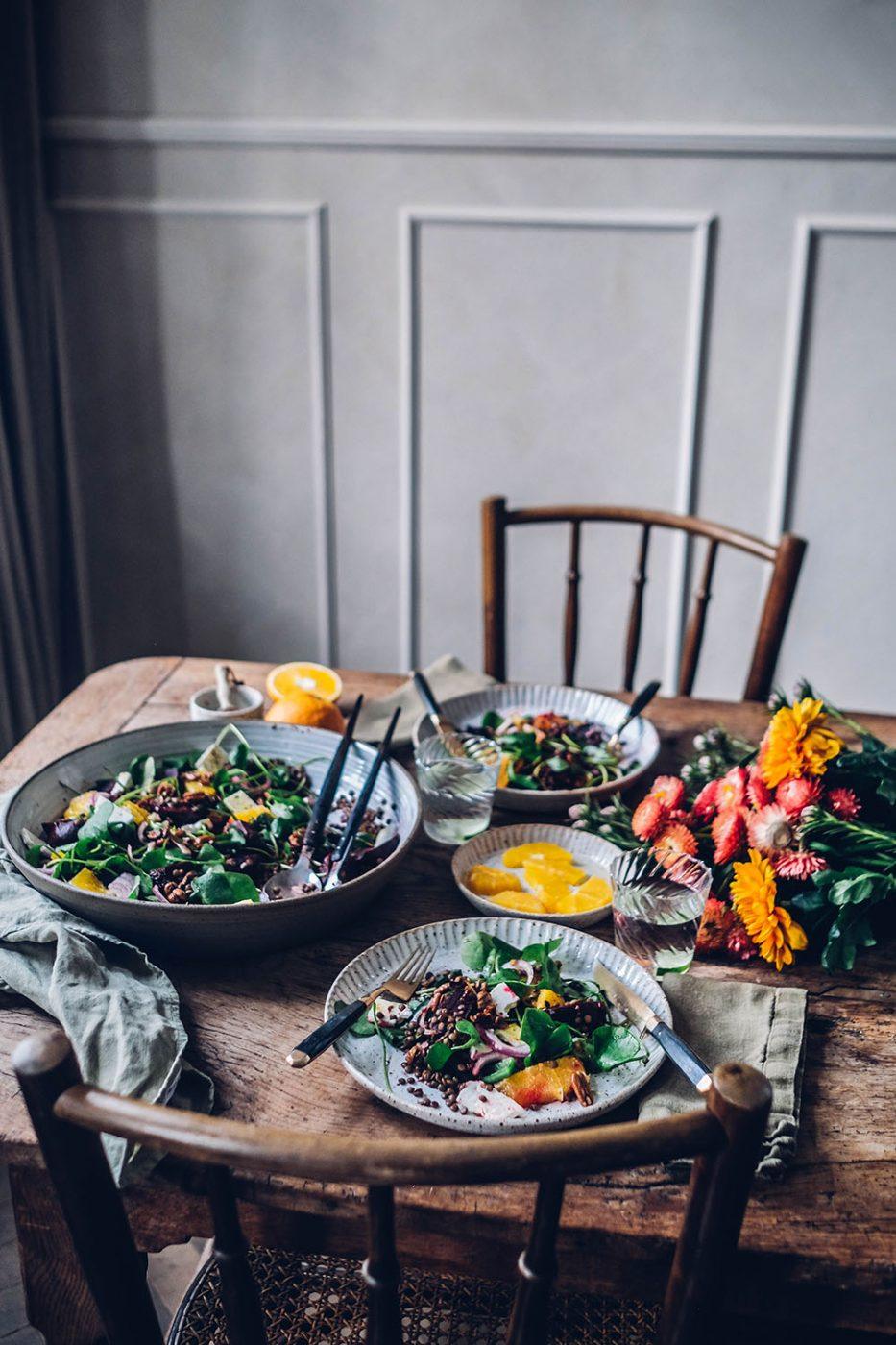
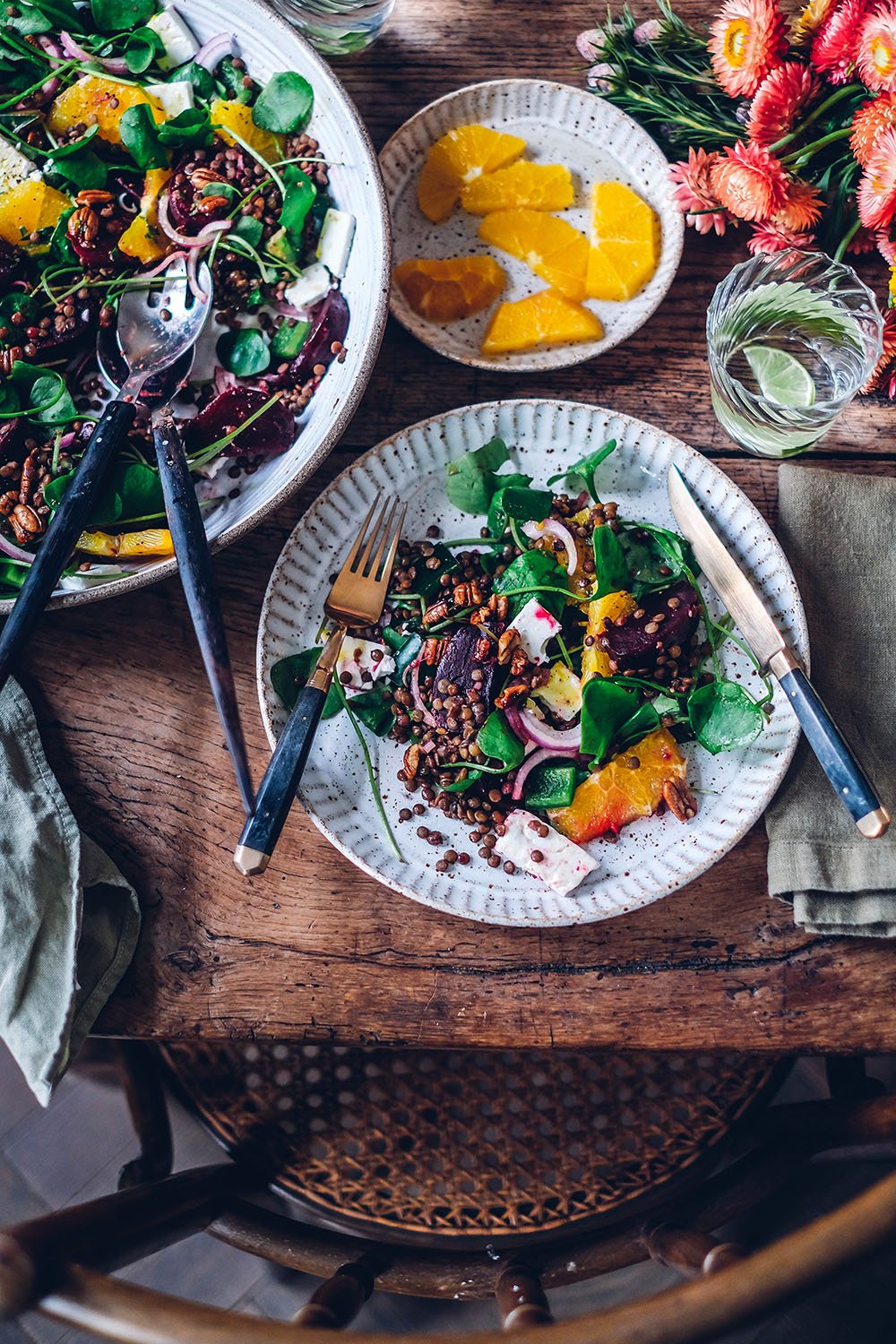
Comments